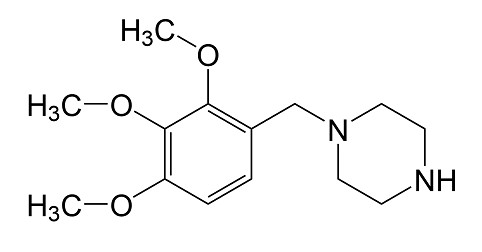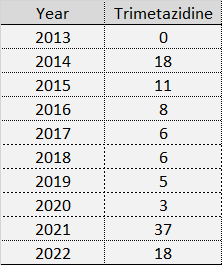Trimetazidine and Doping

Pharmacological Effects
Literature:
Sigmund G, Koch A, Orlovius AK, Guddat S, Thomas A, Schänzer W, Thevis M. Doping control analysis of trimetazidine and characterization of major metabolites using mass spectrometric approaches. Drug Test Anal. 2014 Nov-Dec;6(11-12):1197-205.
"Following its patent application in 1962, the therapeutic agent trimetazidine [1-(2,3,4-trimethoxybenzyl)-piperazine] (Figure 1) was introduced in 1963 under the trade name Vastarel in France for the treatment of (stable) angina pectoris. Ever since, the coronary vasodilator trimetazidine underwent numerous studies concerning its mechanism(s) of action and potential additional fields of medical application, demonstrating among other findings a decrease in coronary vascular resistance, an increased coronary blood flow, the inhibition of 3-ketoacyl coenzyme A thiolase (being a key enzyme in the β-oxidative metabolic pathway of the myocardium), and cytoprotective/anti-ischemic effects in other organs. As a consequence of the 3-ketoacyl coenzyme A thiolase inhibition, improvements in left ventricle dysfunction patients were observed when being treated with trimetazidine due to the lowered demand for oxygen when glucose is utilized instead of free fatty acids. Although being considered a well-tolerated drug, an increasing number of case reports concerning drug-induced parkinsonism, gait disorder, and tremor caused by trimetazidine have been published, resulting in a recommendation for a careful cost-benefit assessment of the drug."
Doping - History
Literature:
Okano M, Thevis M, Sato M, Kageyama S. Analytical detection of trimetazidine produced by metabolic conversion of lomerizine in doping control analysis. Drug Test Anal. 2016 Aug;8(8):869-74.
"Trimetazidine (Figure 1) is widely used for treating angina pectoris. In sports, trimetazidine was identified in 39 of 16725 (0.23%) urine samples between 2008 and 2013 in the World Anti-Doping Agency (WADA) accredited Warsaw laboratory (Poland) and over 39 findings per year in the WADA Cologne laboratory (Germany). This is an early warning sign of trimetazidine abuse among athletes. On 1 January 2014, WADA prohibited the misuse of trimetazidine on the basis of the similarity of its chemical structure to banned stimulants such as benzylpiperazine and the emerging patterns of use. After the official prohibition of trimetazidine use in 2014, one adverse analytical finding of trimetazidine was reported during the 2014 OlympicWinter Games in Sochi. Exactly one year later, the classification of trimetazidine on the WADA prohibited list was moved from sub-section S6.b (specified stimulant) to the newly created sub-section S4.5.3 (metabolic modulators), as it is pharmacologically classified as a modulator of cardiac metabolism. Consequently, trimetazidine was classified as a banned substance both in-competition and out-of-competition."

Positive Findings (AAF = Adveres Analytical Findings) with Trimetazidine - WADA statistic of all worldwide accredited laboratories for doping control:

Trimetazine and excercise capacity (EC)
Murong Xie, Lingjun Jiang, Yaoshan Dun, Wenliang Zhang, Suixin Liu. Trimetazidine combined with exercise improves exercise capacity and anti-fatal stress ability through enhancing mitochondrial quality control, Life Sciences, Volume 224, 2019, Pages 157-168.
download the article
Abstract
Aims: To explore the effects of trimetazidine combined with exercise on EC and anti-fatal stress ability, and illustrate the underlying mechanism.
Methods: C57BL/6 mice were randomly assigned to four groups (n = 11 in each group): the control, exercise, trimetazidine and trimetazidine + exercise (TE) groups. Mice were accordingly given saline (ig), Aerobic exercise (AE), trimetazidine (ig), or a combination of trimetazidine (ig) and AE for five weeks. After the intervention, each group was randomly subdivided into rest and exhaustive exercise (EE) subgroups. The mice in the control-EE and TE-EE subgroups underwent fatal stress experiments. EC and anti-fatal stress ability were assessed respectively. Mitochondrial quality control (MQC) in skeletal muscle were measured at the protein level and the organelle level.
Key findings: A significantly increased exhaustive swimming time was observed in exercise (39.10 ± 12.58 min vs 14.18 ± 4.37 min), trimetazidine (33.73 ± 8.45 min vs 14.18 ± 4.37 min) and TE groups (73.78 ± 18.95 min vs 14.18 ± 4.37 min) compared with that in the control group, and a synergistic effect was detected (P < 0.05). Fatal stress experiments successfully induced skeletal muscle damage, including increased creatine kinase activity, myofibrosis, and impaired antioxidative enzyme system, all those were significantly alleviated by trimetazidine supplementation combined with AE precondition (P < 0.05). Meanwhile, AE and trimetazidine alone or combined, significantly enhanced the MQC in normal mice by activating mitochondrial biogenesis, dynamics and mitophagy, and that in mice underwent fatal stress stimulus (P < 0.05). Significance: This study for the first time found that trimetazidine and AE have synergistic effects on improving EC. Moreover, the combination of both interventions enhances anti-fatal stress ability. Enhancing MQC may be a key mechanism of AE combined with trimetazidine that improves EC and anti-fatal stress ability.
Use as a performance-enhancing drug
see Wikipedia Trimetazidine
Literature
Sigmund G, Koch A, Orlovius AK, Guddat S, Thomas A, Schänzer W, Thevis M. Doping control analysis of trimetazidine and characterization of major metabolites using mass spectrometric approaches. Drug Test Anal. 2014 Nov-Dec;6(11-12):1197-205.
Jarek A, Wójtowicz M, Kwiatkowska D, Kita M, Turek-Lepa E, Chajewska K, Lewandowska-Pachecka S, Pokrywka A. The prevalence of trimetazidine use in athletes in Poland: excretion study after oral drug administration. Drug Test Anal. 2014 Nov-Dec;6(11-12):1191-6.
Okano M, Thevis M, Sato M, Kageyama S. Analytical detection of trimetazidine produced by metabolic conversion of lomerizine in doping control analysis. Drug Test Anal. 2016 Aug;8(8):869-74.
Okano M, Sato M, Kageyama S. Lomerizine, trimetazidine and bis-(4-fluorophenyl)-methylpiperazine in human urine after oral administration of lomerizine dihydrochloride: analysis by liquid chromatography-high resolution-tandem mass spectrometry. Drug Test Anal. 2018 Nov;10(11-12):1689-1697.
Murong Xie, Lingjun Jiang, Yaoshan Dun, Wenliang Zhang, Suixin Liu. Trimetazidine combined with exercise improves exercise capacity and anti-fatal stress ability through enhancing mitochondrial quality control, Life Sciences, Volume 224, 2019, Pages 157-168.